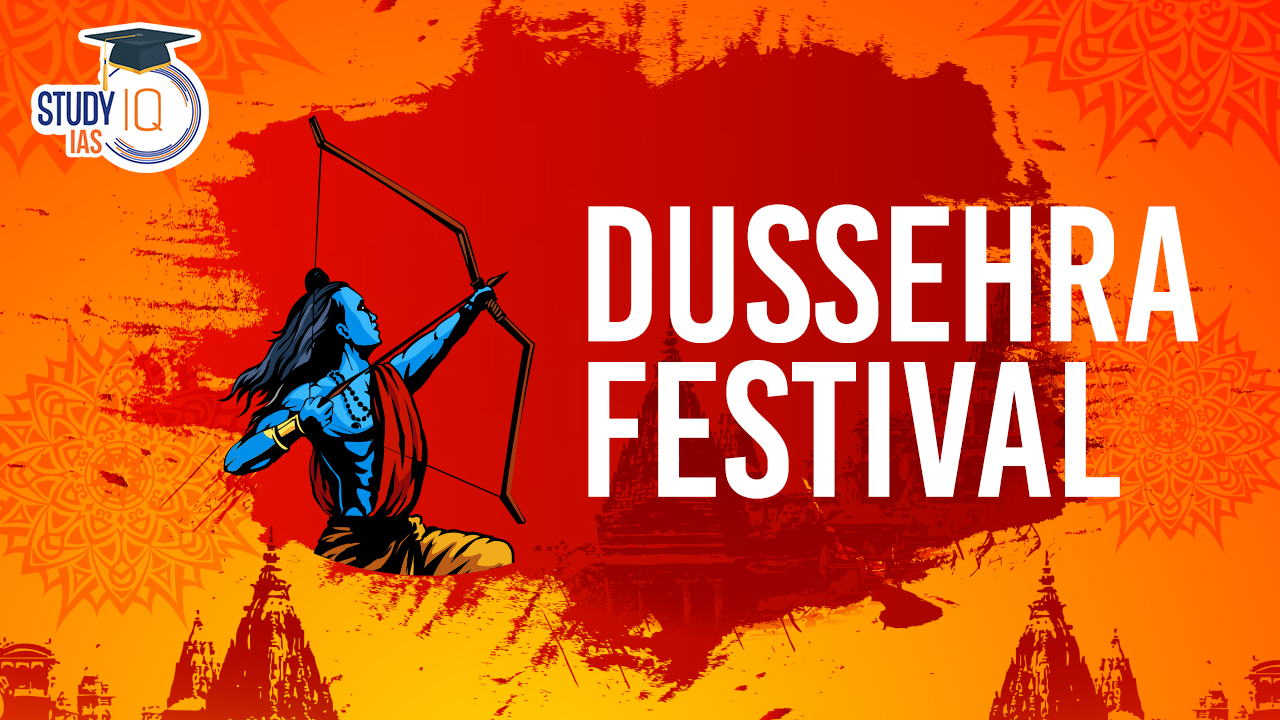Table of Contents
Dussehra Festival 2023
Dussehra, also known as Dasara or Vijayadashami, is a major Hindu festival celebrated every year at the end of Navaratri. It is observed on the tenth day of the month of Ashvin, the seventh in the Hindu Luni-Solar Calendar. The festival typically falls in the Gregorian calendar months of September and October. This year Dussehra Festival 2023 will be celebrated on October 24th (Tuesday).
Dussehra celebrates the victory of good over evil. It is believed that on this day, Lord Rama defeated the demon king Ravana, who had abducted Lord Rama’s wife, Sita. Dussehra is also a time to celebrate the victory of Goddess Durga over the demon Mahishasura. In this article, You will get all about the Dussehra Festival 2023, its celebrations in different parts of India, History, and Cultural Significance.
We’re now on WhatsApp. Click to Join
Dussehra Festival in India
Here are some of the ways that Dussehra Festival is celebrated in different parts of India:
| Dussehra Festival in Different Parts of India | |
| North India | Dussehra is celebrated with the burning of Ravana’s effigy and the staging of Ramlila, a traditional drama that tells the story of Ramayana. |
| East India | Dussehra is celebrated with the Durga Puja festival. This festival honours Goddess Durga and her victory over the demon Mahishasura. |
| South India | Dussehra is celebrated with the Mysore Dasara festival. This festival is a ten-day event that features a variety of cultural and religious activities, including a grand procession with elephants and decorated floats. |
| West India | Dussehra is celebrated with the Garba and Dandiya Raas dances. These dances are performed to celebrate the victory of good over evil and the coming of the festive season. |
Dussehra Festival in North India
- Ramlila: Ramlila is a traditional drama that tells the story of Ramayana, the epic Hindu poem that recounts the adventures of Lord Rama. Ramlila is performed in many different ways in North India, but it typically involves a series of plays that are enacted over the course of several days.
- Burning of Ravana’s effigy: On the day of Dussehra, large effigies of Ravana, Kumbhakarna, and Meghnadh are burnt in bonfires. This symbolizes the defeat of evil and the triumph of good.
- Visiting temples: Many people visit temples on Dussehra to pray and offer their thanks to the gods.
- Exchanging sweets and gifts: Dussehra is a time for people to come together and celebrate. Sweets and gifts are exchanged between friends, family members, and neighbours.
Kullu Dussehra
Kullu Dussehra is a major Hindu festival celebrated in the Kullu valley of Himachal Pradesh, India. It is a seven-day event that is known for its colourful processions, traditional dances, and folk music. The festival begins with a procession of Lord Raghunath, the presiding deity of the Kullu valley. The procession starts from the Raghunath temple in Naggar and travels to the Dhalpur ground in Kullu town. The procession is accompanied by musicians, dancers, and other performers.
On the seventh day of the festival, the burning of Ravana’s effigy takes place. This is a symbolic representation of the defeat of evil. The effigy is burnt on a bonfire in the Dhalpur ground. Kullu Dussehra is a time for people to come together and celebrate the triumph of good over evil. It is a festival that is full of joy, colour, and tradition.
- Procession of Lord Raghunath: The procession of Lord Raghunath is the highlight of the festival. The procession is accompanied by musicians, dancers, and other performers.
- Burning of Ravana’s effigy: The burning of Ravana’s effigy is a symbolic representation of the defeat of evil. The effigy is burnt in a bonfire in the Dhalpur ground.
- Traditional dances: Kullu Dussehra is known for its traditional dances, such as the Kullu Nati and the Kullu Ghoomer.
- Folk music: Kullu Dussehra is also known for its folk music, such as the Kullu Dhol and the Kullu Sarangi.
Dussehra Festival in South India
Dussehra is a major Hindu festival celebrated with great fervour and enthusiasm in South India. It is also known as Dasara, which means “the tenth day” in Sanskrit. The festival falls on the tenth day of the month of Ashwin in the Hindu calendar, which typically falls in the Gregorian months of September and October. In South India, Dussehra is celebrated with a variety of cultural and religious activities. Some of the most popular celebrations include:
- Mysore Dasara: The Mysore Dasara festival in Karnataka is one of the most famous Dussehra celebrations in India. It is a ten-day event that features a variety of cultural and religious activities, including a grand procession with elephants and decorated floats.
- Navratri Golu: Navratri Golu is a tradition in Tamil Nadu and Karnataka where people set up elaborate displays of dolls and figurines in their homes. The dolls represent the different forms of the goddess Durga.
- Bonalu: Bonalu is a festival celebrated in Telangana and Andhra Pradesh to appease the goddess Mahankali. The festival features people carrying decorated pots on their heads in a procession to the temple.
Dussehra Festival in East India
Dussehra, also known as Durga Puja, is a major Hindu festival celebrated with great fervor and enthusiasm in East India, especially in the states of West Bengal, Assam, Odisha, and Tripura. Dussehra celebrates the victory of good over evil, as symbolized by the victory of Goddess Durga over the demon Mahishasura. It is also a time to celebrate the goddess’s other nine forms, which she assumed to defeat the demon.
In East India, Dussehra is celebrated with a variety of cultural and religious activities. Some of the most popular celebrations include:
- Durga Puja: Durga Puja is a five-day festival that involves the worship of Goddess Durga and her nine forms. During the festival, pandals (temporary temples) are erected all over the city, and idols of the goddess are installed. People visit the pandals to pray and offer their respects to the goddess.
- Sindoor Khela: Sindoor Khela is a ritual performed on the last day of Durga Puja. During this ritual, married women smear each other with sindoor (vermilion powder) as a blessing.
- Visarjan: Visarjan is the immersion of the Durga idol in water. This ritual marks the end of Durga Puja and signifies the return of the goddess to her celestial abode.
Dussehra Festival in West India
Dussehra is a major Hindu festival celebrated with great pomp and grandeur in the western regions of India, especially in the states of Gujarat and Rajasthan. It is also known as Navratri in Gujarat, as the festival falls during the nine-day Navratri period. Here are some of the ways that Dussehra is celebrated in the Western Regions:
- Garba and Dandiya Raas: Garba and Dandiya Raas are traditional dances that are performed during Dussehra in Gujarat and Rajasthan. The dances are performed in groups, and the participants wear colourful clothes and jewellery.
- Burning of Ravana’s effigy: On the day of Dussehra, large effigies of Ravana, Kumbhakarna, and Meghnadh are burnt in bonfires. This symbolizes the defeat of evil and the triumph of good.
Bastar Dussehra
Bastar Dussehra is a unique and fascinating festival celebrated in the Bastar district of Chhattisgarh, India. It is a 75-day-long festival that begins on the dark moon day in the month of Shravan and ends on the thirteenth day of the bright moon in the month of Ashwin. It is a major festival for the people of Bastar, and it attracts visitors from all over India and the world. Bastar Dussehra is different from other Dussehra celebrations in India in several ways.
- First, it is much longer, lasting for 75 days.
- Second, it is celebrated in honour of the local deity, Goddess Danteshwari Devi, rather than Lord Rama.
- Third, the festival is marked by a number of unique rituals and traditions, such as the Kachanagari ritual, in which a young girl is chosen to represent Goddess Danteshwari Devi, and the Rath Yatra, in which a chariot carrying the goddess’s idol is pulled through the streets.
History of Vijayadashami or Dussehra Festival
The history of Vijayadashami or Dussehra can be traced back to ancient India. The Vijayadashami festival is believed to have originated in the Vedic period when it was celebrated as a victory of the gods over the demons.
In the Hindu epic Ramayana, Dussehra marks the day when Lord Rama defeated the demon king Ravana. Ravana had kidnapped Rama’s wife, Sita, and held her captive in his kingdom of Lanka. Rama, with the help of his brother Lakshmana and an army of monkeys, travelled to Lanka to rescue Sita. After a long and bloody battle, Rama killed Ravana and rescued Sita. The victory of Rama over Ravana is seen as a victory of good over evil. Dussehra is a time for Hindus to celebrate this victory and reaffirm their commitment to good.
In addition to the Ramayana story, Dussehra is also celebrated in honour of the victory of Goddess Durga over the demon Mahishasura. Durga is the Hindu goddess of strength and power, and she is often depicted as a warrior riding a lion. Mahishasura was a demon who terrorized the world, and Durga was the only one who could defeat him.
Why did Ravana have ten heads?
Ravana was the king of Lanka (modern-day Sri Lanka) in Hindu mythology. He is the main antagonist in the epic Ramayana, where he is portrayed as a ten-headed Rakshasa (demon). Ravana was a powerful and intelligent ruler, but he was also arrogant and cruel. He is known for abducting Sita, the wife of Lord Rama, and taking her to his kingdom of Lanka. Rama eventually defeated Ravana and rescued Sita.
There are a few different interpretations of why Ravana had ten heads.
- One interpretation is that the ten heads represent Ravana’s ten vices: pride, lust, anger, greed, envy, sloth, gluttony, wrath, deceit, and violence.
- Another interpretation is that the ten heads represent Ravana’s ten forms of knowledge: the Vedas, the Upanishads, the Puranas, the Itihasas, the Smritis, the Sutras, the Shastras, the Agamas, the Nigamas, and the Tantra.


 UPSC CDS 1 Final Result 2025 Declared: D...
UPSC CDS 1 Final Result 2025 Declared: D...
 Ramsar Sites in India 2025 List: Names, ...
Ramsar Sites in India 2025 List: Names, ...
 SEBI’s SWAGAT-FI Framework for Low-Ris...
SEBI’s SWAGAT-FI Framework for Low-Ris...

























